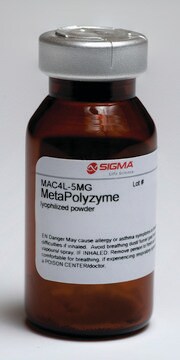SAE0196
Achromopeptidase from bacteria
free of DNA contaminants, suitable for Microbiome research
Sinonimo/i:
Bacterial Protease
About This Item
Prodotti consigliati
Origine biologica
bacterial
Livello qualitativo
Forma fisica
lyophilized powder
Attività specifica
≥1000 U/mg
Caratteristiche
DNA free
tecniche
DNA extraction: suitable
Compatibilità
suitable for cell lysis
applicazioni
cell analysis
Condizioni di spedizione
ambient
Temperatura di conservazione
−20°C
Descrizione generale
Applicazioni
The study of microbial communities has been revolutionized in recent years by the widespread adoption of culture independent analytical techniques such as 16S rRNA gene sequencing and metagenomics. Since DNA contamination during sample preparation is a major problem of these sequence-based approaches, DNA extraction reagents free of DNA contaminants are essential. This product undergoes strict quality control testing to ensure the absence of detectable levels of contaminating microbial DNA using 35 cycles PCR amplification of 16S and 18S rDNA using universal primer sets.
Azioni biochim/fisiol
Caratteristiche e vantaggi
Free of detectable microbial DNA, ensuring the accuracy of metagenomics and other culture-independent sequencing methods
Undergoes strict quality control testing to ensure the absence of detectable levels of contaminating microbial DNA
Optimum pH of 8.5-9 allows for use in a wide range of microbiome studies
Definizione di unità
Avvertenze
Danger
Indicazioni di pericolo
Consigli di prudenza
Classi di pericolo
Resp. Sens. 1
Codice della classe di stoccaggio
11 - Combustible Solids
Classe di pericolosità dell'acqua (WGK)
WGK 3
Punto d’infiammabilità (°F)
Not applicable
Punto d’infiammabilità (°C)
Not applicable
Certificati d'analisi (COA)
Cerca il Certificati d'analisi (COA) digitando il numero di lotto/batch corrispondente. I numeri di lotto o di batch sono stampati sull'etichetta dei prodotti dopo la parola ‘Lotto’ o ‘Batch’.
Possiedi già questo prodotto?
I documenti relativi ai prodotti acquistati recentemente sono disponibili nell’Archivio dei documenti.
Articoli
Enzymatic cell lysis and protoplast prep processes demystified, revealing complex enzymatic reactions during sample preparation.
Il team dei nostri ricercatori vanta grande esperienza in tutte le aree della ricerca quali Life Science, scienza dei materiali, sintesi chimica, cromatografia, discipline analitiche, ecc..
Contatta l'Assistenza Tecnica.








